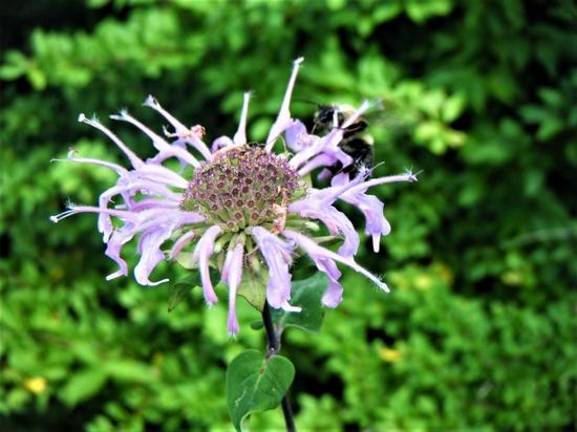Mint’s regal cousin

Summer is flowers’ reign and there are few as regal as bee balm. Plants bear crowns of colorful flowers atop slender square stems that can reach a height of four feet. Bee balm is a member of the mint family. Scientifically called Monarda, two species are common in our region: the scarlet-flowered Monarda didyma which resides along stream-sides and generally moist areas and the lavender-flowered Monarda fistulosa, which prefers dry grassy meadows and roadside embankments. No matter which species you find, both provide food and medicine.
As a medicine, bee balm has long been revered. Native Americans would crush and apply its strongly aromatic leaves to bee stings to reduce swelling and infection, hence its common name. Native Americans living in upstate New York brewed bee balm as a tea. They shared it with colonists who then dubbed bee balm “Oswego tea,” and used it as a replacement for black tea after the Boston Tea Party.
To make your own bee balm tea, simply pinch off a few fresh leaves or snip off a flowering top and drop in a cup of steeping hot water. Bee balm’s flavor resembles oregano more than peppermint but is pervaded by a lemony undertone. Medicinally, it is just what the herbalist ordered. Bee balm is rich in thymol, which is antiseptic, anti-bacterial and anti-fungal—perfect for colds, flus, bacterial and fungal infections. Use internally or externally. Bee balm is also a mild sedative and beneficial in easing digestion, so enjoy a cup with a meal or just before bed.
Bee balm is edible too. Diced leaves take the place of oregano or thyme. I use it to enhance pasta sauces and roasted vegetables. Infuse olive oil with dried leaves and garlic to make a delicious dipping oil for baguettes. Pluck bee balm’s individual flowers from the flowering head and sprinkle atop salads, toss into crepe batter, or freeze in ice cubes. These convey more of a traditional minty flavor than the leaves and bring beauty to any dish.
To preserve your harvest, snip plants at the base of the stem, bundle with string, and hang to dry in an airy room. Once crisp to the touch, snip heads, strip leaves from stems and place in an airtight mason jar for storage. Voila: enjoy the charms of bee balm year-round!
Heather Houskeeper Summer is flowers’ reign and there are few as regal as bee balm. Plants bear crowns of colorful flowers atop slender square stems that can reach a height of four feet. Bee balm is a member of the mint family. Scientifically called Monarda, two species are common in our region: the scarlet-flowered Monarda didyma which resides along stream-sides and generally moist areas and the lavender-flowered Monarda fistulosa, which prefers dry grassy meadows and roadside embankments. No matter which species you find, both provide food and medicine.
As a medicine, bee balm has long been revered. Native Americans would crush and apply its strongly aromatic leaves to bee stings to reduce swelling and infection, hence its common name. Native Americans living in upstate New York brewed bee balm as a tea. They shared it with colonists who then dubbed bee balm “Oswego tea,” and used it as a replacement for black tea after the Boston Tea Party.
To make your own bee balm tea, simply pinch off a few fresh leaves or snip off a flowering top and drop in a cup of steeping hot water. Bee balm’s flavor resembles oregano more than peppermint but is pervaded by a lemony undertone. Medicinally, it is just what the herbalist ordered. Bee balm is rich in thymol, which is antiseptic, anti-bacterial and anti-fungal—perfect for colds, flus, bacterial and fungal infections. Use internally or externally. Bee balm is also a mild sedative and beneficial in easing digestion, so enjoy a cup with a meal or just before bed.
Bee balm is edible too. Diced leaves take the place of oregano or thyme. I use it to enhance pasta sauces and roasted vegetables. Infuse olive oil with dried leaves and garlic to make a delicious dipping oil for baguettes. Pluck bee balm’s individual flowers from the flowering head and sprinkle atop salads, toss into crepe batter, or freeze in ice cubes. These convey more of a traditional minty flavor than the leaves and bring beauty to any dish.
To preserve your harvest, snip plants at the base of the stem, bundle with string, and hang to dry in an airy room. Once crisp to the touch, snip heads, strip leaves from stems and place in an airtight mason jar for storage. Voila: enjoy the charms of bee balm year-round!